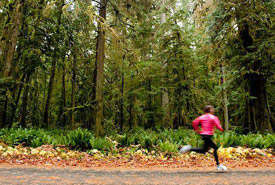Plogging: What it is and why you should try it on your next run

Running in nature (Photo from Masterfile)
Plogging, a combination of jogging and picking up litter, is a trend that is dashing across the world.
Originating in Sweden in 2016, it has now made its way to other parts of the world, including Canada. It began as an organized activity to combat the increase of plastic pollution and is considered a trendy workout that benefits both plogger and nature.
When you add picking up garbage to running, you’re combining squatting, stretching and lifting with the cardio of jogging. This works your glutes, abs and arms, in addition to your already-fired-up leg muscles from running. By alternating from running’s high heart rate to a lower heart rate of stopping to pick up trash, you’re practising a type of high-intensity interval training (HIIT). HIIT is considered to be an effective workout for improving your overall health, including benefits such as increasing your metabolism and strengthening your heart.
You’ll also burn more calories, on average, than jogging alone. According to the Independent, 30 minutes of plogging can help you burn upwards of 20 per cent more calories than if you opted to skip the cleanup.
Not only can plogging help improve your health, it also helps clean up nature.
This Scandinavian workout has helped improve parks across the world, from the U.K., to the U.S. and Canada. The social media hashtag #plogging collects posts from ploggers worldwide, who share their experiences cleaning up areas where they live and work while exercising. The photos are astounding, showing cleanup results that, in some spots, rival those from the Nature Conservancy of Canada’s Conservation Volunteers during a coastal cleanup.
Thanks to social media, not only are ploggers connecting and inspiring one another on an international level, they are coming together nationally and locally to encourage one another to help keep the natural areas in their communities free from litter.
According to CBC, Daniel Fuller, a 32-year-old fitness trainer from Stratford, Ontario., launched a group on Facebook called Plogging Canada in an effort to encourage Canadians to participate in the new fitness craze. Coast to coast, people are posting their trash hauls from their workouts and using the page to connect to other local ploggers. The group already has an impressive following with more and more Canadians joining together to get active and clean up local natural areas.
As spring arrives, plogging is a great way to get outdoors. The snow is melting, and revealed underneath is the previous season’s trash. By incorporating plogging into your workout, you are providing a cleaner habitat for species to live in and creating a more beautiful area for your neighbours to enjoy.
Like all exercise, plogging should be undertaken with caution. Keep an eye out for any hazards along your running route, such as fallen branches, rocks and dips in the trail, and be aware of what you’re picking up. Gloves should always be worn while picking up garbage.
As an avid runner and lifelong nature lover, I can’t wait to try out this new trend. It’s a workout that my body, and the environment, will thank me for!


